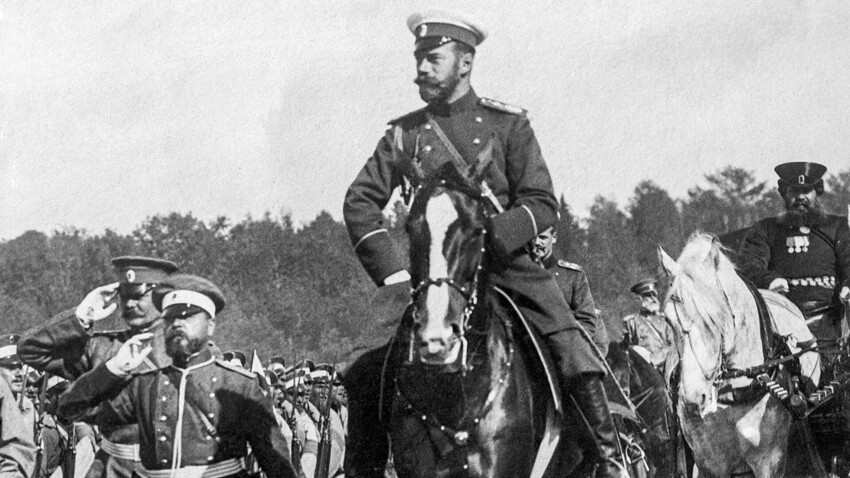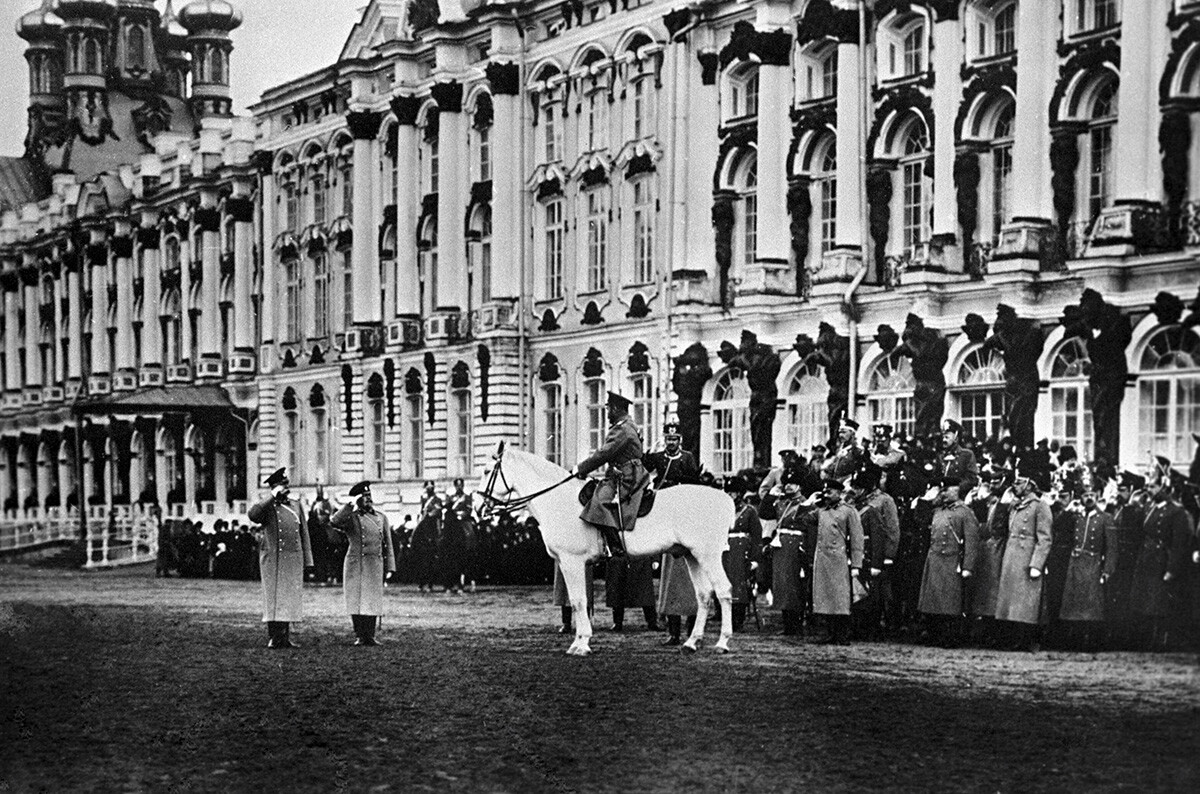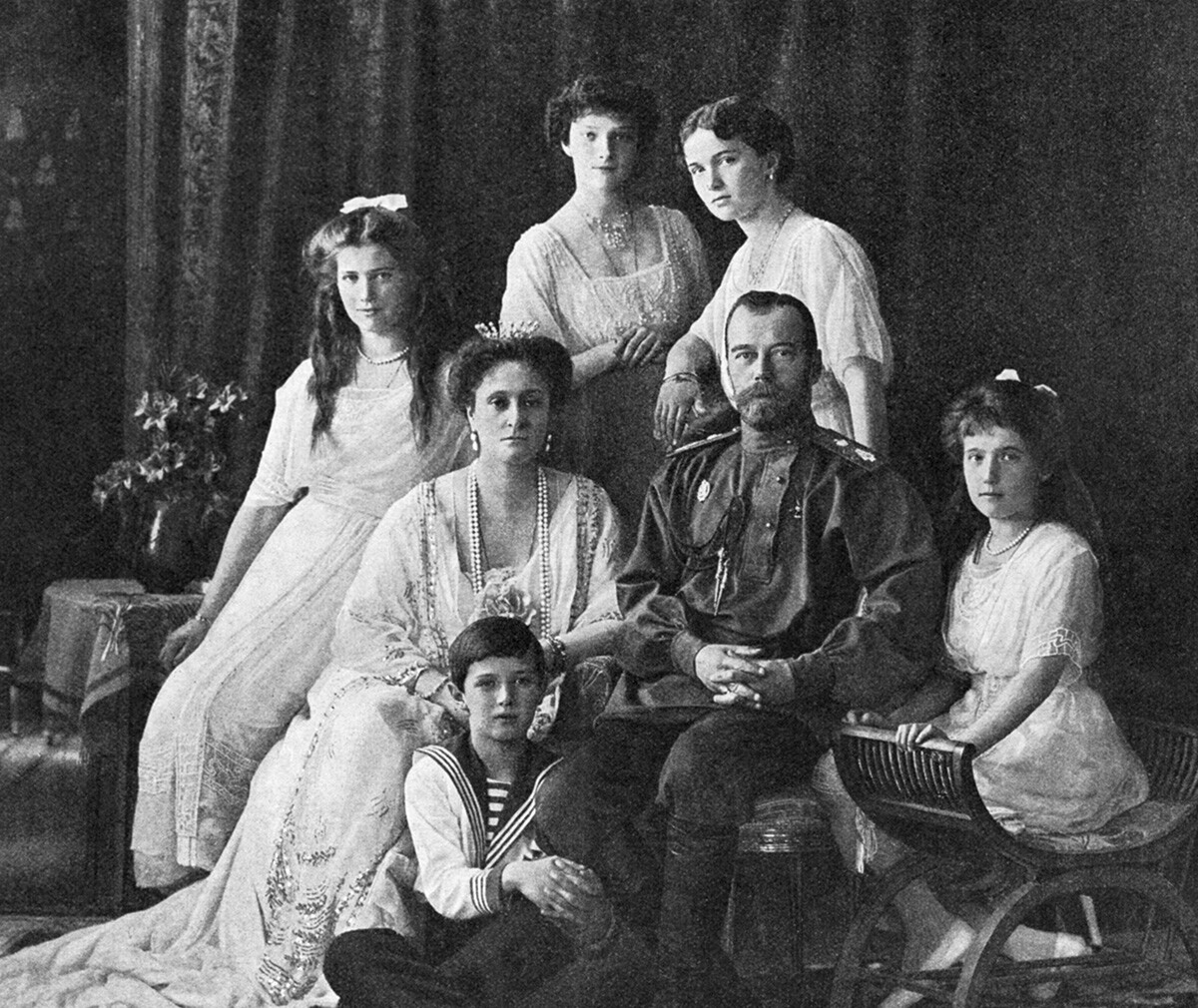
Nicholas II leads marching Russian soldiers along a road during the early days of World War I, 1914
Bettmann/Getty ImagesUndoubtedly, the main event of the year was the beginning of World War I. On July 19, 1914, Germany declared war against the Russian Empire. Below, Peterburgians are reading newspapers with the news about the world’s first global conflict.
On July 20, 1914, Nicholas II addressed the people. From the balcony of the Winter Palace in St. Petersburg, he announced the manifesto about Russia entering the war.
A gigantic crowd of people gathered on Palace Square that day.
The news of war stunned the citizens of the empire and evoked patriotic enthusiasm (the text on the placard reads ‘Victory to Russia and to Slavic people’).
St. Petersburg saw a patriotic demonstration – below is a photo of the procession on Nevsky Avenue.
Sympathy towards Orthodox Christian Serbia also rose – in the photo below, the crowd is greeting a Serbian envoy sitting in a passing carriage.
Volunteers and military men formed endless waiting lines to recruiting stations.
The mobilized were immediately sent to the front.
New recruits were sent off to the army with honors.
Soon enough, many were presented the first awards for courage and valor.
Anti-German sentiments were so high that, in August 1914, Nicholas II ordered to rename St. Petersburg to Petrograd in the Russian manner. The ‘Birzhevye Novosti’ (‘Exchange News’) newspaper wrote: “We went to sleep in St. Petersburg and woke up in Petrograd.”
The entire country was engulfed by fear and the feeling of the unknown. Below, in the city of Miass in the Urals region, people gathered for a mass prayer to grant Russia victory over Germany.
World War I was also the war of new technologies. The Russian military now had its first air forces. In the photo below, aviation squad officers attempt to launch a weather balloon to determine wind speed and atmospheric pressure.
Right when the war started, Vladimir Lenin, the future “leader of the revolution”, was in Austria-Hungary and was arrested on suspicion of espionage. But on August 6, 1914, he was released from prison. Soon, he condemned this “imperialistic” war. Later, it would be him who would pull Russia out of the war and initiate signing a peace treaty (although on disadvantageous terms).
In July 1914, St. Petersburg, was visited by the top officials of France. In the photo, on the deck of the French battleship ‘France’ – President Raymond Poincaré, Prime Minister René Viviani and Vice-Admiral Le Beris.
Below, Nicholas II attends a parade in Tsarskoye Selo.

Against all odds, day-to-day life continued on the territory of the Russian Empire. The imperial family is depicted in the photo below: Nicholas II, Empress Alexandra and their children: son Alexei (sitting) and daughters. From left to right: Maria, Tatiana, Olga and Anastasia.

Below, people are simply enjoying themselves on the skating rink in the Tauride Garden of St. Petersburg.
And this is a professional skating contest on the ‘Field of Mars’ in St. Petersburg.
Not long before the beginning of the war, the emperor and grand princes from the Romanov dynasty participated in the ceremonial laying of the first stone of the Benoit Building, a new structure within the Russian Museum.
At that time, the Silver Age of poetry was raging. Culture, overall, was on the rise and going through changes. Avant-garde art and new names emerged. The entire upper echelon of Peterburgian intelligentsia would gather at the ‘Brodyachaya Sobaka’ (‘Stray Dog’) café.
This is a Siberian Khanty fisherman weaving a ‘gimga’ – a special trap for catching fish.
Below is another pre-war photo: Ilya Repin is painting a portrait of famous singer Feodor Chaliapin at his estate.
Chaliapin snapped ice skating on the rink near Repin’s estate.
And this is 21-year-old Avant-garde poet Vladimir Mayakovsky, the future minstrel of the revolution.
Below, beautiful ballerina Tamara Karsavina is returning to Petrograd after touring with Sergei Diaghilev’s ‘Russian Seasons’ entourage.
In Spring 1914, the St. Petersburg chess tournament took place – one of the more grand events in the history of chess. In the photo below, Russian chess player Alexander Alekhine is playing against Cuban José Raúl Capablanca.
Here, a demonstration of new fire fighting equipment is taking place on Red Square in Moscow…
…while this is a bustling market on Pokrovskaya Square (currently Turgenev Square) in St. Petersburg.
A lot more attention was being put into female education. In this photo – students and teachers of the Preobrazhenskaya Gymnasium for girls in St. Petersburg pose for a group photo.
And this is a regular feast at a dacha (country house), outside the city.
Below is the filled-to-the-brim hall of the Public Library in St. Petersburg.
The following photo depicts a dressing-room in a provincial hospital. A year later, famous author Mikhail Bulgakov, would work in similar conditions, which he would later describe in his ‘A Young Doctor's Notebook’ (in 1914, he enlisted as a volunteer for the Red Cross).
Below, a couple sit in their hammock at the dacha.
Dear readers,
Our website and social media accounts are under threat of being restricted or banned, due to the current circumstances. So, to keep up with our latest content, simply do the following:
If using any of Russia Beyond's content, partly or in full, always provide an active hyperlink to the original material.
Subscribe
to our newsletter!
Get the week's best stories straight to your inbox